I've sub-classed some button controls, since I'm drawing the whole UI myself (to the dialog's hdc). This is to avoid flicker, the intention is that all drawing is done via a single memDC - preventing the staggered update of the UI.
So, I draw everything to the dialog's background, then position some buttons over the regions of the UI that should react to mouse events. So far so good. Or so I thought.
I sub-classed the buttons, using the following WndProc, expecting that Windows would do everything as per normal, except the drawing.
LRESULT CALLBACK invisibleBtnProc(HWND hwndBtn, UINT uMsg, WPARAM wParam, LPARAM lParam)
{
long oldProc = GetWindowLong(hwndBtn, GWL_USERDATA);
switch (uMsg)
{
case WM_PAINT:
ValidateRect(hwndBtn, NULL);
return 0;
case WM_ERASEBKGND:
return 1;
}
return CallWindowProc((WNDPROC)oldProc, hwndBtn, uMsg, wParam, lParam);
}
The buttons are created and subclassed with the following code:
for (i=0; i<n; i++)
{
btn = CreateWindow(WC_BUTTON, L"", WS_VISIBLE|WS_CHILD, 0,0,0,0, hwndDlg, (HMENU)(firstBigBtnId+i), hInst, NULL);
long btnProcCur = GetWindowLong(btn, GWL_WNDPROC);
SetWindowLong(btn, GWL_USERDATA, btnProcCur);
SetWindowLong(btn, GWL_WNDPROC, (long) invisibleBtnProc);
}
When I built this code with MinGW & Code::Blocks, it works flawlessly. (both in debug and release builds)
Unfortunately, when built with MSVC & VS2010, I observe different behaviour. The debug-mode build is okay, but the release build is not. When one of the invisible buttons is clicked, the system is drawing it, obscuring the underlying 'button'.
I've a large WMF (emf? I forget) that needs to be drawn - it's quite slow and produces flicker when the window is resized, for those that wonder why the custom-draw-everything approach.
Here's what I'm seeing:

Note, that before I tried to click on the leftmost button it was not visible - just like the one on the right. Only upon clicking it does windows decide to draw it. Resizing the parent window - (a dialog which triggers a call to InvalidateRect for the dialog) removes the erroneous drawing. Clicking the button once again causes it to be drawn.
Any ideas where I've made a mistake in my thinking?
EDIT: Added code below for a SCCCE (This displays the same unwanted behaviour when built with GCC debug & release, that the original program showed in debug build only)
#include <windows.h>
/* Declare Windows procedure */
LRESULT CALLBACK WindowProcedure (HWND, UINT, WPARAM, LPARAM);
RECT btnRect;
const int btnSize = 150;
const int btnId = 1000;
HINSTANCE hInst;
/* Make the class name into a global variable */
char szClassName[ ] = "CodeBlocksWindowsApp";
int WINAPI WinMain (HINSTANCE hThisInstance,
HINSTANCE hPrevInstance,
LPSTR lpszArgument,
int nCmdShow)
{
HWND hwnd; /* This is the handle for our window */
MSG messages; /* Here messages to the application are saved */
WNDCLASSEX wincl; /* Data structure for the windowclass */
/* The Window structure */
wincl.hInstance = hThisInstance;
wincl.lpszClassName = szClassName;
wincl.lpfnWndProc = WindowProcedure; /* This function is called by windows */
wincl.style = CS_DBLCLKS; /* Catch double-clicks */
wincl.cbSize = sizeof (WNDCLASSEX);
/* Use default icon and mouse-pointer */
wincl.hIcon = LoadIcon (NULL, IDI_APPLICATION);
wincl.hIconSm = LoadIcon (NULL, IDI_APPLICATION);
wincl.hCursor = LoadCursor (NULL, IDC_ARROW);
wincl.lpszMenuName = NULL; /* No menu */
wincl.cbClsExtra = 0; /* No extra bytes after the window class */
wincl.cbWndExtra = 0; /* structure or the window instance */
/* Use Windows's default colour as the background of the window */
wincl.hbrBackground = (HBRUSH) COLOR_BACKGROUND;
/* Register the window class, and if it fails quit the program */
if (!RegisterClassEx (&wincl))
return 0;
/* The class is registered, let's create the program*/
hwnd = CreateWindowEx (
0, /* Extended possibilites for variation */
szClassName, /* Classname */
"Code::Blocks Template Windows App", /* Title Text */
WS_OVERLAPPEDWINDOW, /* default window */
CW_USEDEFAULT, /* Windows decides the position */
CW_USEDEFAULT, /* where the window ends up on the screen */
544, /* The programs width */
375, /* and height in pixels */
HWND_DESKTOP, /* The window is a child-window to desktop */
NULL, /* No menu */
hThisInstance, /* Program Instance handler */
NULL /* No Window Creation data */
);
/* Make the window visible on the screen */
ShowWindow (hwnd, nCmdShow);
/* Run the message loop. It will run until GetMessage() returns 0 */
while (GetMessage (&messages, NULL, 0, 0))
{
/* Translate virtual-key messages into character messages */
TranslateMessage(&messages);
/* Send message to WindowProcedure */
DispatchMessage(&messages);
}
/* The program return-value is 0 - The value that PostQuitMessage() gave */
return messages.wParam;
}
LRESULT CALLBACK invisibleBtnProc(HWND hwndBtn, UINT uMsg, WPARAM wParam, LPARAM lParam)
{
long oldProc = GetWindowLong(hwndBtn, GWL_USERDATA);
switch (uMsg)
{
case WM_PAINT:
ValidateRect(hwndBtn, NULL);
return 0;
case WM_ERASEBKGND:
return 1;
}
return CallWindowProc((WNDPROC)oldProc, hwndBtn, uMsg, wParam, lParam);
}
void onSize(HWND hwnd, WPARAM wParam, LPARAM lParam)
{
RECT mRect;
GetClientRect(hwnd, &mRect);
btnRect.left = (mRect.right - btnSize) / 2;
btnRect.top = (mRect.bottom - btnSize) / 2;
btnRect.right = btnRect.left + btnSize;
btnRect.bottom = btnRect.top + btnSize;
HWND btn;
btn = GetDlgItem(hwnd, btnId);
MoveWindow(btn, btnRect.left, btnRect.top, btnSize, btnSize, false);
InvalidateRect(hwnd, NULL, false);
}
void onPaint(HWND hwnd, WPARAM wParam, LPARAM lParam)
{
HDC hdc;
PAINTSTRUCT ps;
HBRUSH bkBrush, redBrush;
RECT mRect;
GetClientRect(hwnd, &mRect);
hdc = BeginPaint(hwnd, &ps);
bkBrush = CreateSolidBrush(RGB(51,51,51) );
redBrush = CreateSolidBrush(RGB(255,0,0) );
FillRect(hdc, &mRect, bkBrush);
FillRect(hdc, &btnRect, redBrush);
DeleteObject(bkBrush);
DeleteObject(redBrush);
EndPaint(hwnd, &ps);
}
/* This function is called by the Windows function DispatchMessage() */
LRESULT CALLBACK WindowProcedure (HWND hwnd, UINT message, WPARAM wParam, LPARAM lParam)
{
switch (message) /* handle the messages */
{
case WM_CREATE:
HWND tmp;
tmp = CreateWindow("Button", "Press Me", WS_VISIBLE|WS_CHILD, 0,0,0,0, hwnd, (HMENU)btnId, hInst, NULL);
long oldProc;
oldProc = GetWindowLong(tmp, GWL_WNDPROC);
SetWindowLong(tmp, GWL_USERDATA, oldProc);
SetWindowLong(tmp, GWL_WNDPROC, (long)invisibleBtnProc);
return 0;
case WM_DESTROY:
PostQuitMessage (0); /* send a WM_QUIT to the message queue */
break;
case WM_SIZE:
onSize(hwnd, wParam, lParam);
return 0;
case WM_PAINT:
onPaint(hwnd, wParam, lParam);
return 0;
case WM_COMMAND:
switch (LOWORD(wParam))
{
case btnId:
MessageBeep(MB_ICONEXCLAMATION);
break;
}
return 0;
default: /* for messages that we don't deal with */
return DefWindowProc (hwnd, message, wParam, lParam);
}
return 0;
}